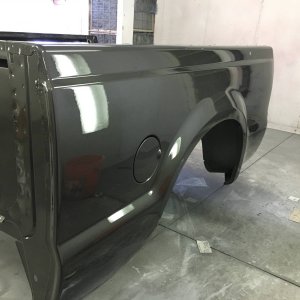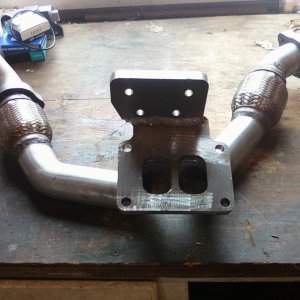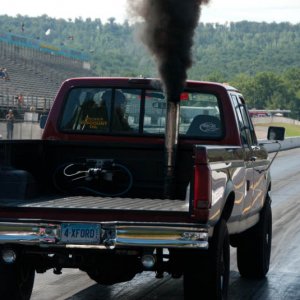We have all seen and many here been party to the max ICP discussions ( and b!tch feasts). I am not looking for what just any person thinks ICP can be run to and not having floating poppets. IMO the people that know for sure what pressures injectors hold to at given ICP before poppets fail to seal are those that have and or actually use flow benches. To me this means injector BUILDERS and a few others with access. Any person that has access to and has done first hand testing on injectors with specific testing of the max ICP where poppets lift IMO would be qualified to give an answer. But in general who better to tell you what their injectors can handle than the guys that actual build them.
I want to qualify this with saying I know each set of injectors in fact each injector has a different point at which the poppet wills start to crack open. What I am looking for is the given safe limit and what those testing have found to be actual numbers on average. Then what has been seen at both extremes.
I was going to include those that had also done track times or even dyno runs. The issue with those from doing some reading is there are just way to many variables even forgetting the ones of just the devices themselves and the environmental factors. But the effects of the tuning itself can have an issue. Have a engine set up running a bit to much fuel and then raise ICP where the poppet floating may reduce fuel can show a HP gain from the actual reduction is fueling caused by the cracked open poppet. I have also seen it mentioned that Dyno runs being so short may not see the effects in the few seconds where a full strip run would. But either of these can be effected by the tuning so I threw those out. Dynos may have some good data but it would live tuning changes while being on the dyno etc to ensure some other factor is not the cause of the changes.
This is speaking of injectors that are commercially available to a typical user even if by request. Not any one offs creations. I know the kind of crazy things Jason, Dave, Nate and others can make.
As a refresher and in general a very informative Max ICP thread to bring anyone that wants needs to be brought up to speed on the subject:
It was started by Tom S over on PSN before the days of PSA back in 2009. It was kept civil and some good info was put forth. I recommend for those with basic questions read it and do so carefully. There are some short and long posts that give very good answers to various things. Read the whole thing.
Maximum ICP Thread
I have put forth a number of questions through out as well as farther down in this post. These were born from reading all the threads I could find on the subject (yes I was bored, with way to much time on my hands) I am pathetic, I know. :lookaround:
I am pathetic, I know. :lookaround:
I felt these questions might help generate thought, discussion, and I personally would like answers to them.
I have not done a completely exhaustive search but gone thru a really good number of threads here and PSN. Here is what I have found:
It seemed in your average group of end users the number most seem and posted when asked is 3200 psi as being the typical max. Where did this number ever come from anyways? Its not from builders, nor is it standard format flow bench data sheets. Not OEM PCM data. So where?
When I look to what has been stated by builder and those who have tested on the bench the limit is 2800-2900 with some being good to 3000psi.
The only numbers I have seen ever mentioned above the 3200 comes only from those that neither are injector builders nor flow bench users. This is based on as far as I can tell from what I know of their history and what has been posted. Many times this might be one in the same.
At the same time every flow bench flow data sheet I have seen as it seems to be the general format has flow data with ICP from 500 up to 3000 PSI. Does this not mean that every set of injectors that is accompanied by a flow data sheet that shows for fuel per time @ 3000 ICP should be expected to be OK to run at that level? The table could show if there was an issue with a drop on flow amount if the table did not jump from 2500 to 3000 but instead as you reach 2800 the tested increments drop to 100psi. This seems to be at somewhat of a conflict with info I found posted.
What good is flow data @ 3000psi if all you can pull is 2850 ICP or whatever?
Would it not be good for the data sheet to show ICP until there is a drop of one injector? (100psi increments once 2800 is reached)
How much if any decline in holding pressure do these injectors typically see? 50K 100K 150K etc..... Something that is holding new may not being holding anymore a year later if set at the ragged edge. Springs decline in tension with each and every compression cycle no matter how well made. Its small but over time there should be a noticeable trend. (explains why Charles mentions pulling it back at least 100 psi from what he found the limit to be.) These are held by springs right.
Now here is the thing. Most of the real informative threads on this happened years ago. 2009 had a number of good ones. What I want to know is has any of this changed at all with any new mods or changes made in the field of building injectors etc...
So this is not about EXTREME ICP unless that is something that has been from modifications/changes made in the last couple years by injector builder. What this is about is where is the line from testing and has anything at all changed since 5 years ago in this area?
Further is anything on the horizon dealing with this in the injector world? (HRT, Nate, Swamps, Casserly, Jim anyone?)
I think if we are seeing higher ICPs being called for in our tuning and we have the builders giving first had accounts of issues at pressures this high some tuning adjustments may be in order.
If anyone want to make any constructive comments or has questions on the subject please feel free. Just make sure it is actually constructive. Any posts looking to derail this into a Extreme ICP vs everyone else I will ask the mods now, to clean it up as they see fit.
If you are just going to post that "I run this much ICP and I see no HP loss or my stuff runs good" do not bother. That's not what this thread is about. Further dyno results or whatever showing no power loss doesn't really tell the story either as the point of a maximum ICP is to GAIN power If its the same why stress things for no benefit.
If a person has more capacity that the amount of fuel he is using and its enough a short dyno run could possibly allow it to still have enough fuel capacity for what is being called for. Say a 400cc/200% where max fuel called for is 230cc. Is this not a possible way to get a better dyno peak vs real world usable peak power output?
I want to qualify this with saying I know each set of injectors in fact each injector has a different point at which the poppet wills start to crack open. What I am looking for is the given safe limit and what those testing have found to be actual numbers on average. Then what has been seen at both extremes.
I was going to include those that had also done track times or even dyno runs. The issue with those from doing some reading is there are just way to many variables even forgetting the ones of just the devices themselves and the environmental factors. But the effects of the tuning itself can have an issue. Have a engine set up running a bit to much fuel and then raise ICP where the poppet floating may reduce fuel can show a HP gain from the actual reduction is fueling caused by the cracked open poppet. I have also seen it mentioned that Dyno runs being so short may not see the effects in the few seconds where a full strip run would. But either of these can be effected by the tuning so I threw those out. Dynos may have some good data but it would live tuning changes while being on the dyno etc to ensure some other factor is not the cause of the changes.
This is speaking of injectors that are commercially available to a typical user even if by request. Not any one offs creations. I know the kind of crazy things Jason, Dave, Nate and others can make.
As a refresher and in general a very informative Max ICP thread to bring anyone that wants needs to be brought up to speed on the subject:
It was started by Tom S over on PSN before the days of PSA back in 2009. It was kept civil and some good info was put forth. I recommend for those with basic questions read it and do so carefully. There are some short and long posts that give very good answers to various things. Read the whole thing.
Maximum ICP Thread
I have put forth a number of questions through out as well as farther down in this post. These were born from reading all the threads I could find on the subject (yes I was bored, with way to much time on my hands)
I felt these questions might help generate thought, discussion, and I personally would like answers to them.
I have not done a completely exhaustive search but gone thru a really good number of threads here and PSN. Here is what I have found:
It seemed in your average group of end users the number most seem and posted when asked is 3200 psi as being the typical max. Where did this number ever come from anyways? Its not from builders, nor is it standard format flow bench data sheets. Not OEM PCM data. So where?
When I look to what has been stated by builder and those who have tested on the bench the limit is 2800-2900 with some being good to 3000psi.
The only numbers I have seen ever mentioned above the 3200 comes only from those that neither are injector builders nor flow bench users. This is based on as far as I can tell from what I know of their history and what has been posted. Many times this might be one in the same.
At the same time every flow bench flow data sheet I have seen as it seems to be the general format has flow data with ICP from 500 up to 3000 PSI. Does this not mean that every set of injectors that is accompanied by a flow data sheet that shows for fuel per time @ 3000 ICP should be expected to be OK to run at that level? The table could show if there was an issue with a drop on flow amount if the table did not jump from 2500 to 3000 but instead as you reach 2800 the tested increments drop to 100psi. This seems to be at somewhat of a conflict with info I found posted.
What good is flow data @ 3000psi if all you can pull is 2850 ICP or whatever?
Would it not be good for the data sheet to show ICP until there is a drop of one injector? (100psi increments once 2800 is reached)
How much if any decline in holding pressure do these injectors typically see? 50K 100K 150K etc..... Something that is holding new may not being holding anymore a year later if set at the ragged edge. Springs decline in tension with each and every compression cycle no matter how well made. Its small but over time there should be a noticeable trend. (explains why Charles mentions pulling it back at least 100 psi from what he found the limit to be.) These are held by springs right.
Now here is the thing. Most of the real informative threads on this happened years ago. 2009 had a number of good ones. What I want to know is has any of this changed at all with any new mods or changes made in the field of building injectors etc...
So this is not about EXTREME ICP unless that is something that has been from modifications/changes made in the last couple years by injector builder. What this is about is where is the line from testing and has anything at all changed since 5 years ago in this area?
Further is anything on the horizon dealing with this in the injector world? (HRT, Nate, Swamps, Casserly, Jim anyone?)
I think if we are seeing higher ICPs being called for in our tuning and we have the builders giving first had accounts of issues at pressures this high some tuning adjustments may be in order.
If anyone want to make any constructive comments or has questions on the subject please feel free. Just make sure it is actually constructive. Any posts looking to derail this into a Extreme ICP vs everyone else I will ask the mods now, to clean it up as they see fit.
If you are just going to post that "I run this much ICP and I see no HP loss or my stuff runs good" do not bother. That's not what this thread is about. Further dyno results or whatever showing no power loss doesn't really tell the story either as the point of a maximum ICP is to GAIN power If its the same why stress things for no benefit.
If a person has more capacity that the amount of fuel he is using and its enough a short dyno run could possibly allow it to still have enough fuel capacity for what is being called for. Say a 400cc/200% where max fuel called for is 230cc. Is this not a possible way to get a better dyno peak vs real world usable peak power output?












